Simon Guerrier's Blog, page 42
September 16, 2020
Doctor Who Magazine 556
 The new issue of Doctor Who Magazine features a cardboard TARDIS set to build, a detailed look at 1964 story Marco Polo and an exhaustive look at the new multi-platform jamboree Time Lord Victorious.
The new issue of Doctor Who Magazine features a cardboard TARDIS set to build, a detailed look at 1964 story Marco Polo and an exhaustive look at the new multi-platform jamboree Time Lord Victorious. The latter includes a brief word from me, as I've written a short story, Lesser Evils , and edited Master Thief by Sophie Iles. There's also stuff from me in the preview for Shadow of the Daleks . These audio adventures are all out next month.
September 15, 2020
V for Victory, by Lissa Evans
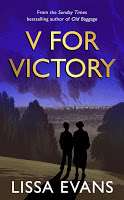 Entirely selfishly, I bought this for the Dr's birthday so that I could read it. It's the third in a trilogy, after Crooked Heart and its prequel,
Old Baggage
- both of which I adored.
Entirely selfishly, I bought this for the Dr's birthday so that I could read it. It's the third in a trilogy, after Crooked Heart and its prequel,
Old Baggage
- both of which I adored. We pick up with young Noel Bostock and his adopted aunt Vee - though she's neither of those things officially. Now going under the name Mrs Margery Owens, she and Noel bugger on through the chaos of north London at the fag-end of the Second World War. At any moment of any day, a V2 might fall on them and it's exhausting - not least because the chores and home-schooling must still somehow be done. Still, there's romance kindling in the air for each of them. And then they both stumble into people who know something of their past - and might expose their secrets...
As before, there's a wealth of telling historical detail worked deftly into the breezy tale, which I knocked through in a matter of days. It's so teeming with life and emotion. We really feel the outrage of Winnie the Warden discovering that her harrowing real-life experience has been filletted by her sister for a sexy novel. Or there's Noel's infatuation with a girl who's moved away:
"Noel recognized Genevieve Lumb's neat but forceful handwriting. Even the thought that she had licked the envelope was quite physically stirring." (p. 53).
The remarkable thing is that these extraordinary, unprecedented times feel utterly real. But it's also a delight to spend time in the company of good people just trying to get by, despite all the crap going on.
I was especially moved by the ending, where Vee and Noel face some tricky emotional stuff relating to his biological parents. It's so perfectly done, so impossible to describe here without spoiling. At one point, Vee wonders what might have happened if she'd not made a connection with this awkward teen at a critical moment, how nearly he might have been lost. But we leave them happy, the war over and a new world on the horizon. After all the devastation, what survives is the love.
September 10, 2020
Where Shall We Run To?, by Alan Garner
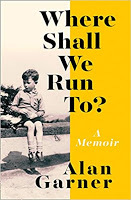 My brother got me this as house-warming present. What feels an age ago but was really at New Year, he and I tramped bits of Alderley Edge described here, a not-too-far car journey from where I now live.
My brother got me this as house-warming present. What feels an age ago but was really at New Year, he and I tramped bits of Alderley Edge described here, a not-too-far car journey from where I now live.The rather fancy, well-to-do area has changed dramatically since Garner's wartime childhood. He vividly conveys dirt and poverty and childhood disease. There's his parents coming to wave at him through a window when he's in hospital with diphtheria, or the childhood friend who he shared adventures with, and,
"Then Marina died." (p. 92)
It's just one example of a devastating punchline. I was particularly hit by his sweet description of the US soldiers stationed nearby, who he'd saluted and call to from his porch as they marched by, and they'd salute and call back as if he were an official watchman. The Yanks include an American despatch rider - "the first black face I'd seen" (p. 72) who is respectful to Garner's mum and gives the boy gum and chocolate, and you feel the connection made, reaching across the ocean from Garner's small, parochial world. It's warm and fun - and then undercut by the final words of the chapter.
"The Yanks went. Their ship was sunk, and they drowned. From the porch, I kept watch." (p. 76)
It's not just the Yanks who are lost; Garner is mourning people, phrases and ways of doing things long since gone. Not all of it is rose-tinted: there's a constant fear of bullies and fights, the teachers are just as capable of violence, and with the war on there's a constant threat of death - a feeling I think we've got used to living with again recently. It's vividly conveyed from the perspective of a child, too, so we sometimes have to join the dots to understand what's happening, such as how seriously ill he was. He's also not always well behaved, such as when he shoves his friend Harold into a clump of nettles.
At the end, we skip forward many years, to the 50s, the 70s and then beyond, with short anecdotes that pick up on elements from before. The book begins with child-Alan finding what he think might be an unexploded bomb; in 1955 and with experience from National Service, he knows to spot a real one. Then there's a sweet coda to a story about a contest at school, where he finally gets his due prize. And finally, a catch-up with Harold in later life.
Garner won a scholarship when still very young which took his life in a very different direction to Harold's - who bunked off school but retained a connection to the local area which came in useful later. In just a few short lines, he's the vividly realised character, putting a bit of stick into local meetings. My first sense was of Garner's envy. But that's not the raw emotion behind this whole exercise in remembrance. In the penultimate sentence of the book, Garner casually mentions "Harold's funeral". Having walked through the world he was part of, we really feel his loss.
September 2, 2020
Vortex 139
 The new issue of Big Finish house magazine Vortex includes me yakking about two things I've written that are out next month.
The new issue of Big Finish house magazine Vortex includes me yakking about two things I've written that are out next month. Lesser Evils is my contribution to the Time Lord Victorious multimedia extravaganza, while The Bookshop at the End of the World is the episode I've written of the eight-episode, eight-author Shadow of the Daleks.
August 24, 2020
Haunting north
The removals people said they'd be here between 8 and 8.30 this morning but arrived just after 7.30 while I was still drinking tea in bed. So the Dr raced into the shower while I hauled on last night's clothes, and then we were in full boxing mode. They parked their enormous lorry in the middle of the street and none of our neighbours objected. I think that's a mark of how friendly things are here - or how pleased they are to be rid of us.
Tomorrow, we move from our house of nine and a half years, and from London where I've lived since October 1999. We're moving north for a new chapter and new life. The children are already there. So it feels momentous and yet anticlimactic. I'm glad to be going and sad to be gone.
With the house over-run by boxes, the Dr and I went for lunch round the corner at our local - the first time either of us have been in a pub since mid-March. It was strange to use the new app to order drinks and food, all part of the careful, socially distanced provisions to keep us and other punters safe, and yet otherwise pick up as if we'd never been away. And then having caught up with landlord Colin after all these months, he was busy when we had finished, so there was no chance to say goodbye.
The week has been full of notable lasts: my daughter's last day at the nursery that's been a fixture in our lives since my son started there in 2013; the last time mowing the lawn yesterday; the last time past the old landmarks. What with everything going on in lockdown, and some personal stuff too, I'm all a bit emotional at the moment, haunted by things past and things to come.
August 11, 2020
Time Lord Victorious timeline
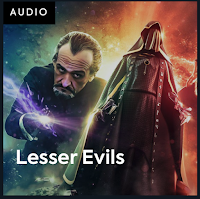 The official Doctor Who people (praise the company!) have released a timeline of forthcoming multimedia jamboree Time Lord Victorious.
The official Doctor Who people (praise the company!) have released a timeline of forthcoming multimedia jamboree Time Lord Victorious.Among the books, comics, audio dramas, escape rooms, figurines and whatever else, there's a whole page devoted to my short story Lesser Evils, including the following sentence from the thing itself:
Death descended on the planet Alexis one bright and crisp, clear morning...
Lesser Evils is performed by Jon Culshaw and features the version of the Master originally played by Anthony Ainley. It's set on a planet I named after the amazing Alexis Deacon, author of Geis.
Buy Lesser Evils from Big FinishJuly 24, 2020
Caligari in the Lancet Psychiatry
 I've written about the 100 year-old movie Das Cabinet des Dr Caligari in the August 2020 issue of the Lancet Psychiatry. You need to pay to read the whole thing, but here's a preview:
I've written about the 100 year-old movie Das Cabinet des Dr Caligari in the August 2020 issue of the Lancet Psychiatry. You need to pay to read the whole thing, but here's a preview:Das Cabinet des Dr Caligari (The Cabinet of Dr Caligari) is now a century old. Even if you've never seen it, much will be hauntingly familiar. The plot is simple enough: wild-eyed showman Dr Caligari (Werner Krauss) has an unsettling stage act involving willowy Cesare (Conrad Veidt), who we're told has been asleep for almost all of his 23 years. Krauss has complete power over this somnambulist, waking him for brief intervals to foretell the future. One eager member of the audience is horrified to be told he'll die that very night—and then does. We soon learn that Caligari sends Cesare out at night to commit murder but, in a shock twist, “Caligari” is revealed to be the director of the nearby asylum. Then, in another shock twist, all of this turns out to be the gothic fantasy of another of the patients (Friedrich Fehér). The staff and other patients at the asylum have all been given roles in his delusion, and the exaggerated, Expressionist production design of the film is the world as seen by, in the language of the time, “a madman”.
July 11, 2020
Tintin, by Herge
 I’m struggling a bit with prose for grown-ups, so over the last month worked my way through The Adventures of Tintin, an eight-volume box-set of the boy reporter’s collected scrapes, including the early, rough Tintin in the Land of the Soviets and the unfinished Tintin and the Alph-Art but not including the especially racist and colonialist Tintin in the Congo from which even Herge distanced himself. (The book is available to buy separately.)
I’m struggling a bit with prose for grown-ups, so over the last month worked my way through The Adventures of Tintin, an eight-volume box-set of the boy reporter’s collected scrapes, including the early, rough Tintin in the Land of the Soviets and the unfinished Tintin and the Alph-Art but not including the especially racist and colonialist Tintin in the Congo from which even Herge distanced himself. (The book is available to buy separately.)My parents still have a bunch of Tintin books that I shared with my brothers. In my head they were always more my younger brother’s but I’m surprised now to discover how few of them I’d read. Running gags, such as the telephone being put through to the butcher, or insurance salesman Jolyon Wagg outstaying his welcome, seemed completely new.
I was also surprised by how funny so much of it is, having thought of Tintin as the po-faced cousin of Asterix, to whom I was devoted. But there’s loads of often very funny slapstick here, whole sequences of panels passing without a word. I wonder what it owes to the comedy of silent film.
The pace is also striking. Written as a newspaper strip but reformatted for book versions, each story licks along at great speed, full of incident and twists. There are plenty of cliffhangers - though, as with so many adventure serials, many of them are undone by outrageous good fortune or sleight of hand on the part of the author. Still, it’s exciting and fun.
And it looks beautiful. Herge's clean line style with no shading and flat colours means that strips that are nearly 100 years old reproduce nicely, and look fantastic on shiny, good quality paper. The style suggests cartoon-faced people in an otherwise convincingly realised world - it's both daft comic strip and gritty realism at the same time.
But also striking is the racist stuff. Even without Tintin in the Congo, there are plenty of crude racial and cultural stereotypes, perhaps the most jaw-dropping in The Broken Ear when Tintin blacks up.
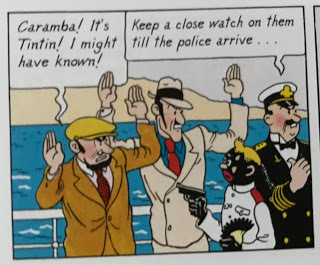
Having nominally bought the collection for my nine year-old son, I started to have second thoughts - and I’m not the only one. On 10 June, just as I was reading this, Amol Rajan was on BBC News to talk about Gone With the Wind being removed from Netflix - just a day after he’d been on to talk about the more recent comedy Little Britain coming down from iPlayer.
“That is fraught with difficulty. Where does it stop? I'm reading Tintin with my son at the moment and an exhibition of tolerance it certainly is not. It reads like one long parade of racial cliches.” (Tweet by Amol Rajan, 10 June 2020)He’s right, and there’s plenty here that made me uncomfortable - not least in those books that I'd read before without noticing this aspect. How strange, too, for a series of adventures for children to feature opium dens, slavery, alcoholism, kidnap and murder. I think Herge’s clean lines and flat colours, plus the slapstick stuff, are deceptive: Tintin’s a noble character in a world that is corrupt and cruel and dangerous.
Without wishing to excuse or downplay the racist depictions here, there’s clearly also an attempt to offer more nuance and counterpoint, such as in this sequence from The Blue Lotus where Tintin and his friend Chang try to dispel a few cultural myths.
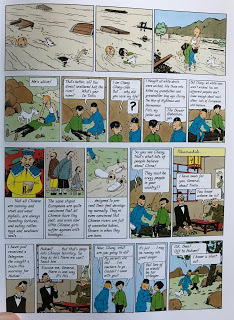
I wonder how much of this is later revisionism. There’s clearly some of that going on. The jump in style between Tintin in the Land of the Soviets and the next book, Tintin in America, is so marked because the latter was redrawn. There’s evidence, too, that the revised books weren’t published in their original order. In Cigars of the Pharaohs, in volume 2 of this collection, Tintin is recognised because someone has a copy of Destination Moon, which is in volume 6.
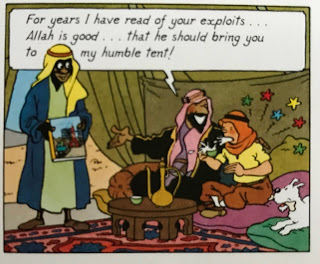
(This also suggests that Tintin is a celebrity because of his adventures, and the accounts of them exist in his own world as colourful comic books, too.)
My guess is that this moment in King Ottaker’s Sceptre is also a later edit, perhaps after someone wrote in:
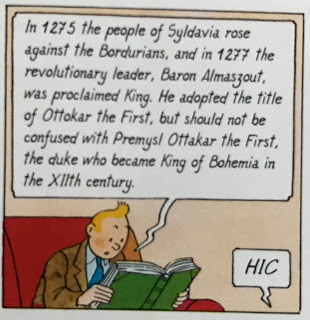
Anyway. There’s a notable shift in gear with The Crab With the Golden Claws, which feels more mature and better plotted, and introduces us to the brilliant Captain Archibald Haddock, a drunk old sea-dog with a heart of gold. Part of what makes this story feel epic is where it breaks the newspaper-strip format, with full and half-page panels. When these happen out in the desert, the effect is like suddenly going widescreen, the adventures directed by David Lean. Again, it’s a story about drug-smuggling and there are racial caricatures, but Tintin solves the mystery using pluck and intelligence rather than good fortune.
After the disappointing The Shooting Star (an odd one about an alien island that produces huge mushrooms), we’re onto what’s surely the classic pairing - The Secret of the Unicorn and Red Rackham’s Treasure. I knew this one well and it’s a really good mystery, greatly helped by the focus on Captain Haddock. In Secret, we’re told the year is 1958 which came as a bit of a shock reading the adventures in sequence. Some 30 years have passed since Land of the Soviets and Tintin and his dog have not aged a day. It turns out that the original version of the strip was published between June 1942 and January 1943, so this is again another revision for the collected version. More than that, the stories have existed in a kind of timeless state. While Tintin in America mentioned Al Capone by name, we’ve had little sense of the real world. There has been no mention of the Second World War, the occupation of Tintin's native Belgium or that anything might have changed. I’ve since looked this up and see that The Crab With the Golden Claws was the first that Herge wrote while under occupation, and it’s tempting to try and see the gear-shift in the storytelling as some kind of response to real-world events. I’m not sure, but would like to know more.
Secret ends with Tintin directly addressing the reader to say the story is continued. Red Rackham’s Treasure begins with various suitors claiming to be descendants of the notorious pirate to get in on the treasure hunt. One of these, apparently as a sight gag, is a black man with very dark skin and big lips - so this kind of racist caricature isn’t only part of the early days of the series. On page 186 of my edition, we’re given the date Wednesday 23 July, suggesting this is still 1958.
There’s more continuity cock-up in The Seven Crystal Balls where we’re told of Bianca Castafiore that,
“she turns up in the oddest places: Syldavia, Borduria, the Red Sea… She seems to follows us around!” (p. 13)But this is only the second time we’ve met her, and The Red Sea Sharks is in six books’ time. On the next page, General Alcazar seems to have met Haddock before, but Haddock wasn’t in that previous adventure at all. Land of Black Gold then features two more characters returning from previous books, and depends on a lot of coincidence. The books keep finding dramatic new locations round the world, but feel increasingly repetitive.
Then there’s something very different with Destination Moon and Explorers on the Moon. This strip originally began in 1950, well ahead of the Space Race, and it's fascinating that neither the US nor USSR are the first to get to the lunar surface. The rocket here is, apparently purposefully, reminiscent of the Nazi's V-2 rocket, even down to the distinctive red and white check. That surely makes Professor Calculus a comedy version of Von Braun. Again, there's no mention of Nazis, the shadow of occupation or the Cold War that followed - and was in the background as this story was written. Tintin is the first human to walk on the Moon but this extraordinary historic moment happens outside of time.
Herge took pains to get the details right, and it's fun to see a spacecraft built to accommodate the fact that its crew would all be knocked unconscious by G-force. The astronauts speculate about the formation of craters (we now know they're created by impacts), and land and drive huge, heavy vehicles on the lunar surface that would be far too massive and costly to get there. I was also taken by the science they actually conduct:
“EXTRACT FROM THE LOG BOOK BY PROFESSOR CALCULUS 4th June - 2150 hrs. (G.M.T.) Wolff and I spent the day studying cosmic rays, and making astronomical observations. Our findings have been entered progressively in Special Record Books Nos. I and II. The Captain and Tintin have nearly finished assembling the [reconnaissance] tank.” (p. 98)They set up an observatory and a theodolite, and drive round in an enormous tank. And then they discover a huge cave system. Surely, surely, the moment Tintin lets go his safety line and drops into the abyss to rescue Snowy is an influence on Doctor Who doing the same in the The Satan Pit (2006).
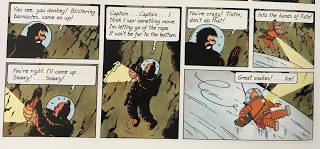

So much of this is jaw-dropping, remarkable and new. Really, my only problem with the Moon story is the villain, who returns from King Ottaker's Sceptre in a simple revenge plot, while a rival bunch of scientists eavesdrop on what Tintin is up to. It feels inconsequential.
Once they're back on Earth, Tintin is recognised as the first person to walk on the Moon in several of the books that follow. The Calculus Affair is set on Earth but feels no less huge given that Professor Calculus has - as well as all his technology for getting to the Moon - invented a super weapon. There's a chilling moment when we see a city destroyed, though it proves to be a model for demonstration purposes. Even so, this analogy for the Bomb is really effective. At one point, we also spot a book, "German Research in World War II", the first time the Tintin series references the conflict.
Tintin in Tibet (serialised 1958-59, book version 1960) seems quite similar to Nigel Kneale's Yeti stories - his TV play The Creature (1955) and the movie version The Abominable Snowman (1957) - and I wondered if Kneale had been an influence. Here, Tintin is on the trail of his friend Chang, last seen by us in The Blue Lotus - 15 books previously, and first published in the 1930s. Clearly, not so much time has passed for the two young friends. Tintin now seems to have a psychic ability, knowing innately that Chang is alive and in need of saving. Psychic powers seem permissible when he's among exotic natives.
The Castafiore Emerald is on a much smaller scale and set largely at Haddock's home, Marlinspike Hall. Haddock is not the most patient or progressive of people but is horrified by the treatment of a group of Travellers nearby and offers them land on which to camp. They are then suspected when Bianca Castafiore is robbed - playing into racial cliches. Yet Tintin maintains that the Travellers are innocent, even when evidence suggests otherwise. It's Herge trying to play against racist assumptions but there's no challenging of or comeuppance for the prejudiced authorities, and the Travellers leave without a word. The story's heart is in the right place but it's odd. The culprit turns out to be a bit of a joke, and there's little sense of the injustice done to the Travellers. In fact, a missing watch rather invites us to suspect them, too.
Flight 714 to Sydney involves the return of a whole load of friends and foes from previous books, and the plot reminded me a lot - and not in a good way - of Indiana Jones and the Kingdom of the Crystal Skull. There are more returning characters in Tintin and the Picaros, including characters not seen since all the way back in The Broken Ear. If that's not very original, the story is full of suspense - our heroes walking headlong into a gilded cage, and a great sequence at the end when they get caught up in a crowd as they race to save the Thompsons from execution.
Our last sight of Tintin is in a tiny panel at the top of the final page. We then hear him on the final row, a speech bubble snaking away to a departing aircraft. And that's it: a rather understated end to his adventures and a great shame. For all the repeated jokes and perils, and the myriad returning characters that are hard to keep track of, it's all still fun - and now and again really thrilling.
The collection ends with Herge's script and rough sketches for two-thirds of Tintin and Alph-Art. It's fascinating to see his process, and the difference between the roughest of rough sketches and the couple of examples or more carefully realised outlines. The story itself is quite different from what's gone before - involving a celebrity modern artist who makes sculptures based on the letters of the alphabet. But there's the usual runaround and chases, Tintin surviving various attempts to shoot him and blow him up. It's hard to judge without the last third. Would it have done something different?
I'm also amazed that it's not been completed officially, and that, like Asterix, there aren't new adventures of Tintin. For one thing, the movie suggested an openness to adaptation on the part of the licence-holders. There's surely a story in what Tintin did during the war years, or in what he's up to now.
But then I think part of Tintin's appeal, and the only possible response to the racism contained in the stories, is that he's a thing of the past.
July 9, 2020
Shadow of the Daleks
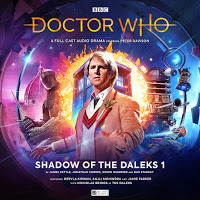 I've written one of the eight episodes of Shadow of the Daleks, a thrilling new audio adventure for the Fifth Doctor which is out later this year.
I've written one of the eight episodes of Shadow of the Daleks, a thrilling new audio adventure for the Fifth Doctor which is out later this year.Written and recorded in lockdown, the eight 25-minute episodes are each written by a different writer and using the same cast of actors in different roles: Peter Davison (as the Doctor), Nicholas Briggs (the Daleks), Dervla Kirwan, Anjli Mohindra and Jamie Parker.
The blurb for mine goes like this:
Something is very wrong. The Fifth Doctor is lost in the Time War, heading for an encounter with his oldest and deadliest enemies... the Daleks!
The Bookshop at the End of the World by Simon GuerrierSee also:Davison vs Daleks - more about Shadow of the Daleks at the Big Finish website
It’s very easy to forget yourself and get lost in a bookshop. But in some bookshops more than most...
July 8, 2020
Time Scope
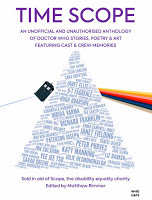 I very nobly gave a couple of things to Time Scope, a new unofficial and unauthorised anthology of Doctor Who stories, poetry and art - 100% of the money from which is going to the charity Scope. It's edited by Matthew Rimmer.Buy Time ScopeMy things are both off-cuts from my work for Big Finish Productions. First, there's Survivors, an initial sketch outline I wrote in December 2009 about what might happen next to companion Sara Kingdom (Jean Marsh) after the events of my trilogy of stories,
Home Truths
, The Drowned World and The Guardian of the Galaxy, including the incarnation of the Doctor I would have paired her up with.
I very nobly gave a couple of things to Time Scope, a new unofficial and unauthorised anthology of Doctor Who stories, poetry and art - 100% of the money from which is going to the charity Scope. It's edited by Matthew Rimmer.Buy Time ScopeMy things are both off-cuts from my work for Big Finish Productions. First, there's Survivors, an initial sketch outline I wrote in December 2009 about what might happen next to companion Sara Kingdom (Jean Marsh) after the events of my trilogy of stories,
Home Truths
, The Drowned World and The Guardian of the Galaxy, including the incarnation of the Doctor I would have paired her up with.Then there's the pre-title sequence I wrote for my first draft of The Mega, a six-episode story based on an original outline from 1970 by Bill Strutton (writer of 1965 TV story The Web Planet). At the time, the plan was to record The Mega using just three actors: Katy Manning (who played companion Jo Grant onTV), Richard Franklin (who played UNIT’s Captain Yates) and John Levene (UNIT’s Sergeant Benton). Around the time I was commissioned for this, news came of the sad death of Nicholas Courtney - who'd played UNIT's Brigadier Lethbridge-Stewart on TV - and in my first audio play. I wanted to acknowledge his loss as well as set up the framing of the story, so wrote this opening scene. Then things changed and it no longer fitted.
Time Scope also includes contributions from both Katy Manning and Richard Franklin, as well as a number of other cast and crew from the various decades of Doctor Who.
Simon Guerrier's Blog
- Simon Guerrier's profile
- 60 followers



